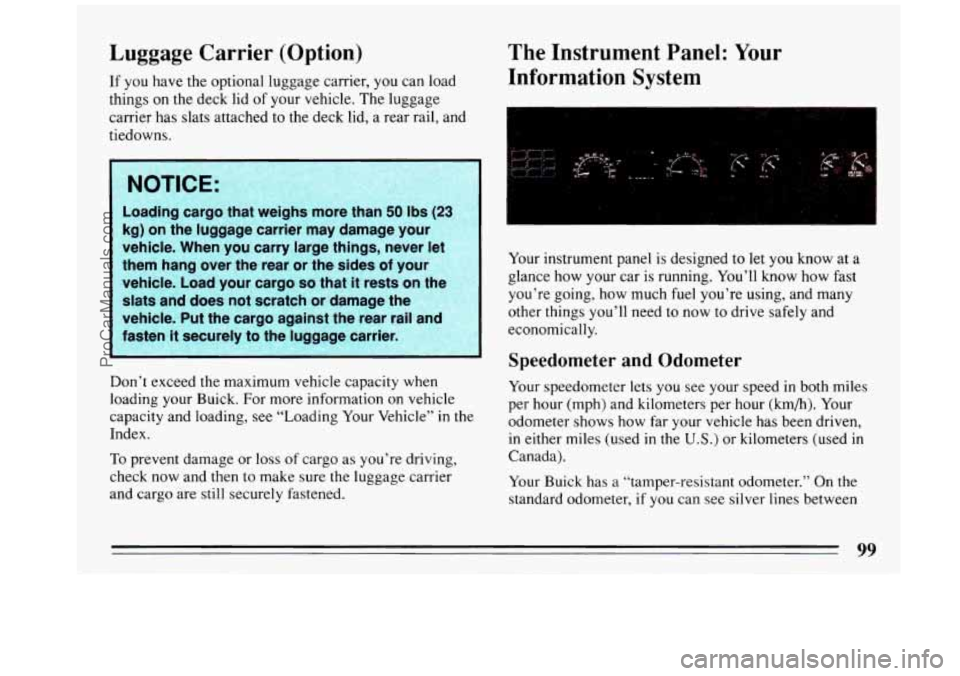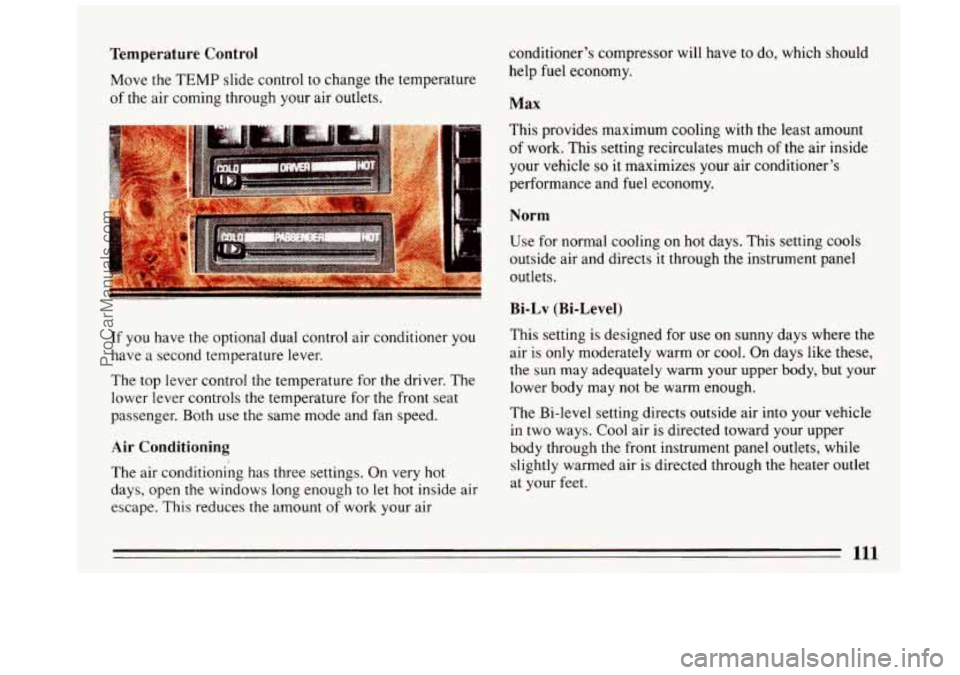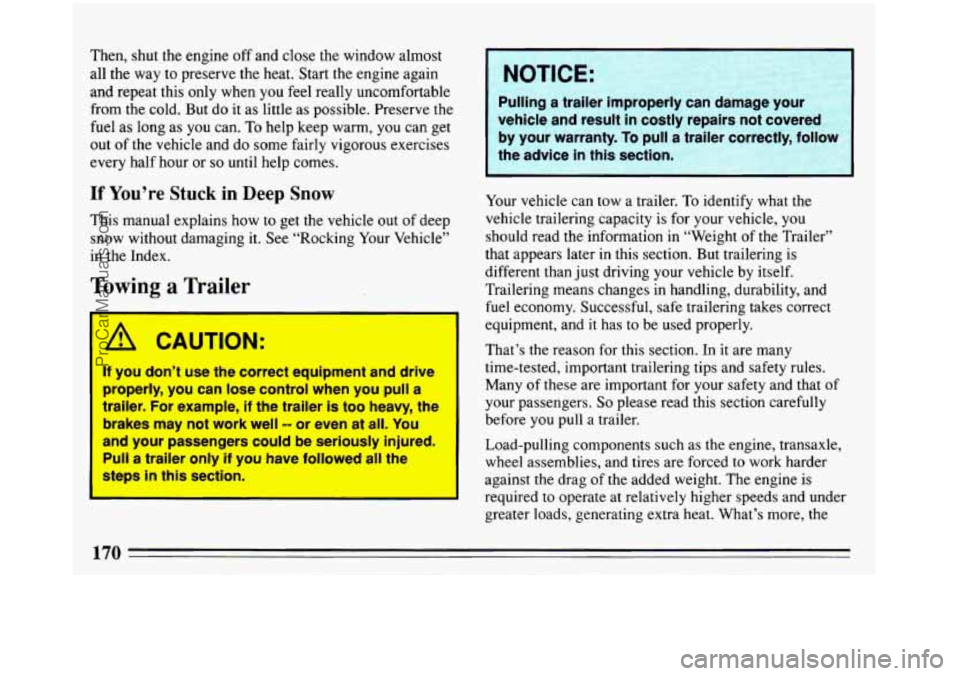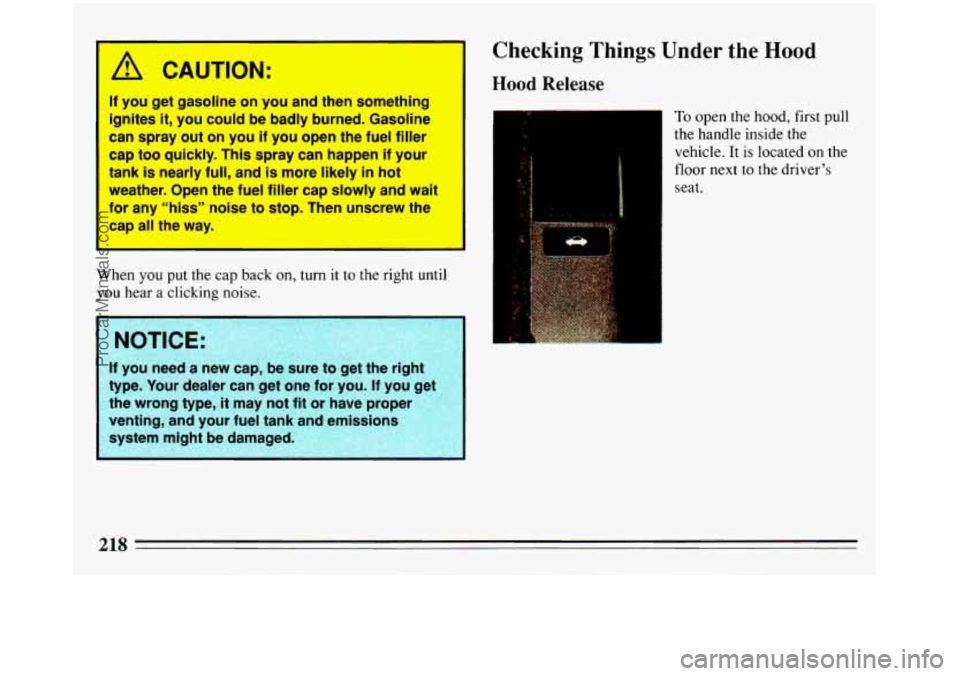1993 BUICK REGAL fuel cap
[x] Cancel search: fuel capPage 101 of 308

Luggage Carrier (Option)
If you have the optional luggage carrier, you can load
things
on the deck lid of your vehicle. The luggage
carrier has slats attached to the deck lid, a rear rail, and
tiedowns.
NOTICE:
Loading cargo that weighs more than 50 Ibs (23
kg) on the luggage carrier may damage your
vehicle. When you carry large things, never let
them hang over the rear or the sides
of your
vehicle. Load your cargo
so that it rests on the
slats and does not scratch
or damage the
vehicle. Put the cargo against the rear rail and
fasten
it securely to the luggage carrier.
\ia , -~~”,~,,””,,~,~~.~,~~--.~~~,,~, L ,,*., ’L <““
The Instrument Panel: Your
Information System
Don’t exceed the maximum vehicle capacity when
loading your Buick. For more information on vehicle
capacity and loading, see “Loading Your Vehicle” in the
Index.
To prevent damage or loss of cargo as you’re driving,
check now and then to make sure the luggage carrier
and cargo are still securely fastened. Your
instrument panel is designed to let you know at
a
glance how your car is running. You’ll know how fast
you’re going, how much fuel you’re using, and many
other things you’ll need to now to drive safely and
economically.
Speedometer and Odometer
Your speedometer lets you see your speed in both miles
per hour (mph) and kilometers per hour (km/h). Your
odometer shows how far your vehicle has been driven,
in either miles (used
in the U.S.) or kilometers (used in
Canada).
Your Buick has
a “tamper-resistant odometer.” On the
standard odometer, if you can
see silver lines between
99
ProCarManuals.com
Page 103 of 308

When one of the warning lights comes on and stays on
when you are driving,
or when one of the gages shows
there may be a problem, check the section that tells
you
what to do about it. Please follow the manual’s advice.
Waiting to do repairs can be costly
-- and even
dangerous.
So please get to know your warning lights
and gages. They’re a big help.
Fuel Gage
UNLEADEL,
FUEL
ONLY
Your fuel gage shows about
how much
fuel is in your
tank. It works
only when
the engine is on. When the
indicator nears
“E,” you
still have a little fuel left.
You need to get more right
away.
Here are
four concerns some owners have had about the
fuel gage. All these situations are normal and indicate
nothing wrong with the
fuel gage.
8 At the gas station, the gas pump shuts off before the
gage reads
“F”.
indicated. For example, the gage indicated 1/2 full,
but
it took more -- or less -- than half of the tank’s
capacity
to fill it.
e It takes more (or less) gas to fill up than the gage
e The gage moves a little when you turn a corner,
speed
up, or stop your vehicle.
When
you turn the engine off, the gage doesn’t go all
the
way back to “E”.
Low Fuel Light
LOW
FUEL
When your fuel gage reads
in the red band, this light
will
go on. You should get
more fuel as soon
as you
can.
101
ProCarManuals.com
Page 113 of 308

Temperature Control
Move the TEMP slide control to change the temperature
of the air coming through your air outlets. conditioner’s
compressor will have to do, which should
help fuel economy. Max
This provides maximum cooling with the least amount
of work. This setting recirculates much of the air inside
your vehicle
so it maximizes your air conditioner’s
performance and fuel economy.
Norm
Use for normal cooling on hot days. This setting cools
outside air and directs it through the instrument panel
outlets.
Bi-Lv (Bi-Level)
If you have the optional dual control air conditioner you
have a second temperature lever.
The top lever control the temperature for the driver. The
lower lever controls the temperature for the front seat
passenger. Both use
the same mode and fan speed.
Air Conditioning
The air conditioning has three settings. On very hot
days, open
the windows long enough to let hot inside air
escape.. This reduces the amount of work your air This setting
is designed for
use on sunny days where the
air is only moderately warm or cool. On days like these,
the
sun may adequately warm your upper body, but your
lower body may not be warm enough.
The Bi-level setting directs outside air into your vehicle
in two ways.
Cool air is directed toward your upper
body through the front instrument panel outlets, while
slightly warmed air is directed through the heater outlet
at your feet.
111
ProCarManuals.com
Page 172 of 308

Then, shut the engine off and close the window almost
all the way to preserve the heat. Start the engine again
and repeat this only when you
feel really uncomfortable
from the cold. But do it as little
as possible. Preserve the
fuel as long as you can.
To help keep warm, you can get
out
of the vehicle and do some fairly vigorous exercises
every half hour
or so until help comes.
If You’re Stuck in Deep Snow
This manual explains how to get the vehicle out of deep
snow without damaging it. See “Rocking Your Vehicle”
in the Index.
Towing a Trailer
(n CAUTION:
If you don’t use the correct equipment and drive
properly, you can
lose control when you pull a
trailer. For example,
if the trailer is too heavy, the
brakes may not work well
-- or even at all. You
and your passengers could be seriously injured.
Pull a trailer only if you have followed all the
steps
in this section.
I NOTICE:
Pulling a trailer improperly can damage your
vehicle and result
in costly repairs not covered
by your warranty.
To pull a trailer correctly, follov
the advice in this section. ‘I
Your vehicle can tow a trailer. To identify what the
vehicle trailering capacity is for your vehicle, you
should read the information in “Weight
of the Trailer”
that appears later in this section. But trailering is
different than just driving your vehicle by itself.
Trailering means changes in handling, durability, and
fuel economy. Successful, safe trailering takes correct
equipment, and it has
to be used properly.
That’s the reason for this section. In
it are many
time-tested, important trailering tips and safety rules.
Many
of these are important for your safety and that of
your passengers.
So please read this section carefully
before
you pull a trailer.
Load-pulling components such as the engine, transaxle,
wheel assemblies, and tires are forced to work harder
against the drag of the added weight. The engine is
required to operate at relatively higher speeds and under
greater loads, generating extra heat. What’s more, the
170
- -
ProCarManuals.com
Page 173 of 308

trailer adds considerably to wind resistance, increasing
the pulling requirements.
All of that means changes in:
Handling
Durability
0 Fuel economy
If
You Do Decide To Pull A Trailer
If you do, here are some important points.
There are many different laws having to do with
trailering. Make sure your rig will be legal, not only
where you live but also where you’ll be driving. A
good source for this information can be state or
provincial police.
0 Consider using a sway control.
You can ask a hitch dealer about sway controls.
Don’t tow a trailer at all during the first 500 miles
(800 km) your new vehicle is driven. Your engine,
axle or other parts could be damaged.
Then, during the first 500 miles (800 km) that you
tow a trailer, don’t drive over 50 mph (80 km/h) and
don’t make starts at full throttle. This helps your engine and other
i)a’rts of your
vehicle wear in at the
heavier loads.
Three important considerations have to do with weight:
Weight of the Trailer
How heavy can a trailer safely be?
It should never weigh more than
1,000 pounds (450 kg).
But even that can be too heavy.
It depends on how you plan to use your rig. For
example, speed, altitude, road grades, outside
temperature and how much your vehicle is used to pull
a
trailer are all important. And, it can also depend on any
special equipment that you have on your vehicle.
You can ask your dealer for our trailering information or
advice, or
you can write us at Buick Motor Division,
Customer Assistance Center,
902 E. Hamilton Avenue,
Flint,
MI 48550.
In Canada, write to General Motors of Canada Limited,
Customer Assistance Center,
1908 Colonel Sam Drive,
Oshawa, Ontario L1H
8P7.
Weight of the Trailer Tongue
The tongue load (A) of any trailer is an important
weight
to measure because it affects the total capacity
weight of your vehicle. The capacity weight includes the
ProCarManuals.com
Page 215 of 308

Part 6 Service And Appearance Care
vehicle, and a section devoted to its appearance care.
Part
6 includes:
ServiceTips
...................................................................... 214
Fuel ........................................................................\
.....
HoodRelease ..................................................................... 218
EngineOil ....................................................................... \
AirCleane r.. ..................................................................... 225
Automatic Transaxle Fluid ...........................................................
Enginecoolant .................................................................... 228
Power Steering Fluid .......................... % ....................................
Windshield Washer Fluid ............................................................ 232
Brakes ........................................................................\
...
Battery ........................................................................\
.. 235
BulbReplacement ................................................................. 236
LoadingYourVehicle ...............................................................
Tires ........................................................................\
....
Appearancecare ..................................................................
Vehicle Identification Number (VIN) ..................................................
FusesandCircuitBreakers ........................................................... 257
Capacities and Specifications ......................................................... 263
ProCarManuals.com
Page 219 of 308

Filling Your Tank The cap is behind a hinged door on the left side of your
vehicle.
11ne vapor IS nlghly Tlarnrnao
violently, and that can cause very Dad injuries.
Don’t smoke if you’re near gasoline or refuelin
your vehicle. Keep sparks, flames, (rr4erials away
+rqm ga-line. ~~2;: LMk
While refueling, hang the cap inside the fuel door.
To take off the cap, turn it slowly to the kft
(counterclockwise).
217
ProCarManuals.com
Page 220 of 308

A CAUTION:
If you get gasoline on you and then something
ignites it, you could be badly burned. Gasoline
can spray out on you if you open the fuel filler
cap too quickly, This spray can happen if your
tank is nearly full, and: is more likely in hot
weather. Open the fuel filler cap slowly and wait
for any “hiss” noise to stop. Then unscrew the
cap all the way.
When you put the cap back on, turn it to the right until
you hear a clicking noise.
If you need a new cap, be sure to get the right
type. Your dealer can get one for you.
If you get
the wrong type, it may not fit
or have proper
venting, and your fuel tank and emissions system might be damaged.
Checking Things Under the Hood
Hood Release
To open the hood, first pull
the handle inside the
vehicle. It is located on the
floor next to the driver’s
seat.
218
.-
ProCarManuals.com